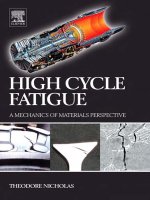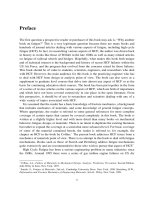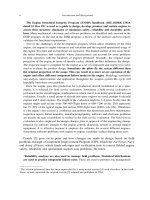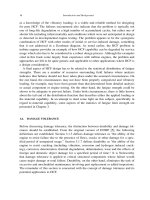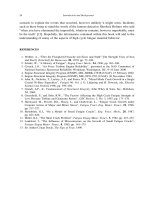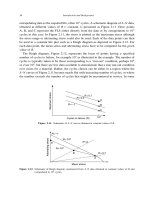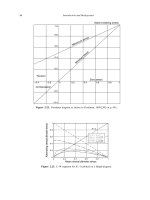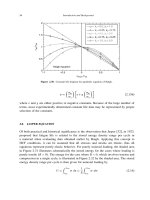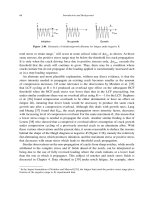High Cycle Fatigue: A Mechanics of Materials Perspective part 16 pdf
Bạn đang xem bản rút gọn của tài liệu. Xem và tải ngay bản đầy đủ của tài liệu tại đây (158.47 KB, 10 trang )
136 Introduction and Background
and 0.11% carbon, normalized. While most of the materials show an increase of fatigue
limit strength as a function of frequency, 0.86% carbon steel and, to a lesser extent Armco
iron, show a maximum stress at a frequency of approximately 10 kHz.
The early results of Jenkin [72] were obtained using a resonance technique on simply
supported beams excited electromagnetically, but the specimen dimensions were much
smaller than those used by Lomas et al., thereby producing a range of resonant frequencies
that were much higher. Later, Jenkin and Lehmann [73] further extended the frequency
range by using even smaller bend specimens excited pneumatically with pressure pulses.
The first experiments of Jenkin [72] on copper, Armco iron and mild steel were able
to easily cover a frequency range up to 1 kHz. Their results showed that “materials
( similar to those tested) gain slightly in their strength to resist fatigue as the speed
goes up, but for most practical speeds the gain is insignificant.” Jenkin and Lehmann
[73] achieved frequencies up to nearly 20 kHz and showed significant frequency effects.
They question, however, their own mathematical analysis of the strains based on beam
deflection (contributed by Prof. Love) and the purely elastic behavior of the materials
which might affect the smaller bar (higher frequency) tests in a systematic manner.
The results of the tests by Lomas et al. [71], shown in Figure 3.48, were obtained
from resonance tests on cantilever beams of different dimensions in order to achieve
a wide range of natural frequencies. Of note is the characteristic shape of the curves
where the fatigue limit strength, corresponding to 10
8
cycles, increases with frequency
up to a maximum and then decreases with further increase in frequency for almost all
of the ferrous alloys tested. As pointed out by the authors, the grave difference in the
results with those of Jenkin is that the peak is obtained at a very different frequency. In
Figure 3.48, the peak is seen to occur in the 1–2 kHz regime compared to 10 kHz for
Jenkin (Figure 3.47) for a similar class of alloys. While these results are cited sometimes
as an example of frequency effects on the fatigue or endurance limit (see Collins [74] for
example), it is this author’s opinion that aspects of the resonance methods used may be
responsible for the apparent effects and discrepancies between investigators. Of greatest
concern is that there exists a maximum value of fatigue limit strength with frequency
among several different alloys, yet this maximum occurs near the same frequency for each
of the alloys. Of unknown significance is that the data point at each frequency is obtained
with a different size cantilever beam, but the same geometry beam is used for each of the
materials at a given frequency. The observed behavior, however, is in contradiction with
observed strain rate effects in many metallic materials [70] and the modeling of such
effects where a monotonically increasing effect of strength with strain rate is the norm.
∗
While it is not the intent of this book to critique the referenced observations in detail,
∗
As pointed out earlier, strain rate effects in metals have been studied almost exclusively in the inelastic regime
of material behavior and constitute the field of dynamic plasticity. Strain rate effects under nominally elastic
conditions are widely considered to be nonexistent.
Accelerated Test Techniques 137
12% Ni
–
25% Cr
36% Ni
–
12% Cr
FREQUENCY-CYCLES PER SEC.
ENDURANCE LIMT-TONS PER SQ. IN. AT 10
8
CYCLES
En 56A
En 8A
En 3A
En 30A,
30 tons per sq in
2.5% Cr-Mo-W-V,
Heat treat B
2.5% Cr-Mo-W-V,
Heat treat A
19
20
21
22
23
24
25
26
27
28
28
29
30
31
32
33
34
35
36
37
38
39
18
19
20
21
22
23
24
25
26
27
100 300 1,000 3,000
a
b
c
Figure 3.48. Endurance stress as a function of frequency for several materials [71].
138 Introduction and Background
it is important to point out some of the potential problems that might be encountered
when using resonance tests on simple structural components for obtaining fatigue limit
strengths. Of the many concerns, hysteretic heating can lead to changes in behavior
even though Morrissey and Nicholas [75] have shown that, in 20 kHz resonance tests
on titanium, the effect of temperature rise when running tests without external cooling
is negligible. Other issues that have to be considered in conducting resonance tests are
the material damping, the structural damping from the experimental apparatus such as
supports or grips, and the aerodynamic damping when conducting high frequency tests
in air. Of prime concern is that the geometry of the specimen has to be different for each
frequency tested in order to achieve different resonant frequencies. This can also raise
potential issues regarding the effective stressed area or volume or the stress gradient in
bending for different thickness specimens. It should also be noted that these types of tests
are not pure resonance tests but, rather, are forced vibrations of lightly damped systems,
conducted at or near the resonant frequencies of the test article. The analysis that leads
to interpretation of the experimentally observed quantities such as peak displacements
is quite complicated, and the ability to maintain the test at a resonant frequency under
constant conditions is very difficult. The cited observations of Lomas et al. [71] and
the comparisons of his data with similar data from Jenkin and Lehmann [73] serve to
point out the need to carefully analyze and interpret experimental findings when using
resonance techniques for determination of fatigue limit strengths.
REFERENCES
1. Morgan, J.M. and Milligan, W.W., “A 1 kHz Servohydraulic Testing System”, High Cycle
Fatigue of Structural Materials, W.O. Soboyejo, and T.S. Srivatsan, eds, The Minerals, Metals
& Materials Society, 1997, pp. 305–312.
2. Mayer, H., “Fatigue Crack Growth and Threshold Measurements at Very High Frequencies”,
International Materials Reviews, 44(1), 1999, pp. 1–34.
3. Marines, I., Dominguez, G., Baudry, G., Vittori, J F., Rathery, S., Doucet, J P., and Bathias,
C., “Ultrasonic Fatigue Tests on Bearing Steel AISI-SAE 52100 at Frequency of 20 and
30 kHz”, Int. J. Fatigue, 25, 2003, pp. 1037–1046.
4. Gough, H.J., The Fatigue of Metals, Ernst Benn Limited, London, 1926.
5. Smith, J.H., “Some Experiments on Fatigue of Metals”, Jour. Iron and Steel Inst., Pt. II., 1910.
6. Moore, H.F. and Jasper, T.M., “An Investigation of the Fatigue of Metals, Bulleting No. 136”,
Eng. Expt. Stat., Univ. Illinois, Urbana, 1924.
7. Schütz, W., “A History of Fatigue”, Engineering Fracture Mechanics, 54, 1996, pp. 263–300.
8. Ransom, J.T. and Mehl, R.F., “The Statistical Nature of the Endurance Limit”, Metals Trans.,
185, 1949, pp. 364–365.
9. Epremian, E. and Mehl, R.F., “Investigation of Statistical Nature of Fatigue Properties”,
NACA-TN-2719, June 1952.
10. Sinclair, G.M., “An Investigation of the Coaxing Effect in Fatigue of Metals”, ASTM Proceed-
ings, 52, 1952, pp. 743–758.
Accelerated Test Techniques 139
11. Forsyth, P.J.E., The Physical Basis of Metal Fatigue, Blackie & Son Ltd, London, 1969.
12. Maennig, W W., “Planning and Evaluation of Fatigue Tests”, ASM Handbook, Volume 19,
Fatigue and Fracture, ASM International, Materials Park, 1996, pp. 303–313.
13. Moore, H.F. and Wishart, H.B., “An ‘Overnight’ Test for Determining Endurance Limit. Proc.
ASTM”, 33, Part II, 1933, pp. 334–347.
14. Prot, M., “Un Nouveau Type de Machine D’Essai des Metaux a la Fatigue par Flexion Rota-
tive”, Rev. Metall., 34, 1937, 440; see also: Prot, M., “Fatigue Tests Under Progressive Load.
A New Technique for Testing Materials”, Rev. Métall., 45(12), December 1948, pp. 481–489.
15. Ward, E.J., Schwartz, R.T., and Schwartz, D.C., “An Investigation of the Prot Accelerated
Fatigue Test”, Proc. ASTM, 53, 1953, pp. 885–891.
16. Corten, H.T., Dimoff, T., and Dolan, T.J., “An Appraisal of the Prot Accelerated Fatigue Test”,
Proc. ASTM, 54, 1954, pp. 875–894.
17. Dolan, T.J., Richart, F.E., Jr., and Work, C.E., “The Influence of Fluctuations in Stress
Amplitude on the Fatigue of Metals”, Proceedings ASTM, 49, 1953, p. 646.
18. Hempel, M., “Performance of Steel under Repeated Loading”, Fatigue in Aircraft Structures,
A.M. Freudenthal, ed., Academic Press, New York, 1956, pp. 83–103.
19. Epremian, E. and Mehl, R.F., “A Statistical Interpretation of the Effect of Understressing on
Fatigue Strength. Fatigue with Emphasis on Statistical Approach”, ASTM STP 137, American
Society for Testing and Materials, 1952, pp. 58–69.
20. Vitovec, F.H. and Lazan, B.J., “Strength, Damping and Elasticity of Materials Under Increasing
Reversed Stress with Reference to Accelerated Fatigue Testing”, Proc. ASTM, 55, 1955,
pp. 844–862.
21. Nicholas, T. and Maxwell, D.C., “Evolution and Effects of Damage in Ti-6Al-4V under High
Cycle Fatigue”, Progress in Mechanical Behaviour of Materials, Proceedings of the Eighth
International Conference on the Mechanical Behaviour of Materials, ICM-8, F. Ellyin, and
J.W. Provan, eds Vol. III, 1999, pp. 1161–1166.
22. Maxwell, D.C. and Nicholas, T., “A Rapid Method for Generation of a Haigh Diagram
for High Cycle Fatigue”, Fatigue and Fracture Mechanics: 29th Volume, ASTM STP 1321,
T.L. Panontin, and S.D. Sheppard, eds, American Society for Testing and Materials, West
Conshohocken, PA, 1999, pp. 626–641.
23. Gallagher, J.P. et al., “Improved High Cycle Fatigue Life Prediction”, Report # AFRL-ML-
WP-TR-2001-4159, University of Dayton Research Institute, Dayton, OH, January, 2001 (on
CD ROM).
24. Gallagher, J. et al., “Advanced High Cycle Fatigue (HCF) Life Assurance Methodologies”,
Report # AFRL-ML-WP-TR-2005-4102, Air Force Research Laboratory, Wright-Patterson
AFB, OH, July 2004.
25. Ruschau, J.J., Nicholas, T., and Thompson, S.R., “Influence of Foreign Object Damage
(FOD) on Fatigue Life of Simulated Ti-6Al-4V Airfoils”, Int. Jour. Impact Engng, 25, 2001,
pp. 233–250.
26. Bellows, R.S., Muju, S., and Nicholas, T., “Validation of the Step Test Method for Generating
Haigh Diagrams for Ti-6Al-4V”, Int. J. Fatigue, 21, 1999, pp. 687–697.
27. Bathias, C., “Relation Between Endurance Limits and Thresholds in the Field of Gigacycle
Fatigue”, Fatigue Crack Growth Thresholds, Endurance Limits, and Design, ASTM STP 1372,
American Society for Testing and Materials, West Conshohocken, PA, 2000, pp. 135–154.
28. Bellows, R.S., Bain, K.R., and Sheldon, J.W., “Effect of Step Testing and Notches on the
Endurance Limit of Ti-6Al-4V”, Mechanical Behavior of Advanced Materials, MD-Vol. 84,
D.C. Davis et al., eds, ASME, New York, 1998, p. 27.
140 Introduction and Background
29. Morrissey, R.J., McDowell, D.L., and Nicholas, T., “Frequency and Stress Ratio Effects in
High Cycle Fatigue of Ti-6Al-4V”, Int. J. Fatigue, 21, 1999, pp. 679–685.
30. Moshier, M.A., Hillberry, B.M., and Nicholas, T., “The Effect of Low-Cycle Fatigue Cracks
and Loading History on the High Cycle Fatigue Threshold”, Fatigue and Fracture Mechanics:
31st Volume, ASTM STP 1389, G.R. Halford, and J.P. Gallagher, eds, American Society for
Testing and Materials, West Conshohocken, PA, 2000, pp. 427–444.
31. Golden, P.J., Bartha, B.B., Grandt, A.F., Jr., and Nicholas, T., “Measurement of the Fatigue
Crack Propagation Threshold of Fretting Cracks in Ti-6Al-4V”, Int. J. Fatigue, 26, 2004,
pp. 281–288.
32. Caton, M.J., “Predicting Fatigue Properties of Cast Aluminum by Characterizing Small-Crack
Propagation Behavior”, PhD Dissertation, University of Michigan, 2001.
33. Nicholas, T., “Step Loading for Very High Cycle Fatigue”, Fatigue Fract. Engng. Mater.
Struct., 25, 2002, pp. 861–869.
34. Lin, S K., Lee, Y L., and Lu, M W., “Evaluation of the Staircase and the Accelerated Test
Methods for Fatigue Limit Distributions”, Int. J. Fatigue, 23, 2001, pp. 75–83.
35. Dixon, W.J. and Mood, A.M., “A Method for Obtaining and Analyzing Sensitivity Data”, J.
Amer. Stat. Assn., 43, 1948, pp. 109–126.
36. Finney, D.J., Probit Analysis, 3rd ed., Cambridge University Press, 1971.
37. Fisher, R.A., Statistical Methods for Research Workers, 14th Edition, Oliver and Boyd Ltd,
Edinburgh, 1969.
38. A Guide for Fatigue Testing and the Statistical Analysis of Fatigue Data, ASTM STP 91-A,
2nd ed., American Society for Testing and Materials, 1963, pp. 12–13.
39. Braam, J.J. and van der Zwaag, S., “A Statistical Evaluation of the Staircase and the ArcSin
√
P
Methods for Determining the Fatigue Limit”, Journal of Testing and Evaluation, JTEVA, 26,
1998, pp. 125–131.
40. Davoli, P., Bernasconi, A., Filippini, M., Foletti, S., and Papadopoulos, I.V., “Independence of
the Torsional Fatigue Limit Upon a Mean Shear Stress”, Int. J. Fatigue, 25, 2003, pp. 471–480.
41. Little, R.E. and Jebe, E.H., Statistical Design of Fatigue Experiments, Applied Science Pub-
lishers, Essex, 1975.
42. Brownlee, K.A., Hodges, J.L. Jr., and Rosenblatt, M., “The Up-and-Down Method with Small
Samples”, J. Amer. Stat. Assn., 48, 1953, pp. 262–277.
43. Dixon, W.J., “The Up-and-Down Method for Small Samples”, J. Amer. Stat. Assn., 60, 1965,
pp. 967–978.
44. Efron, B. and Tibshirani, R.J., An Introduction to the Bootstrap, Chapman and Hall, New York,
1993.
45. Morrissey, R.J. and Nicholas, T., “Staircase Testing of Titanium in the Gigacycle Regime”,
presented at 3rd International Conference on Very High Cycle Fatigue (VHCF-3), Ritsumeikan
University, Shiga, Japan, 16–19 September 2004.
46. Pascual, and Meeker, “Estimating Fatigue Curves with the Random Fatigue-Limit Model”,
Technometrics, 41, No. 4, with comments, November 1999, pp. 277–302.
47. MIL-HDBK-5G, Metallic Materials and Elements for Aerospace Vehicle Structures, 2,1
November 1994, pp. 9–100.
48. Berens, A.P. and Annis, C., “Characterizing Fatigue Limits for Haigh Diagrams”, Proceedings
of the 5th National Turbine Engine High Cycle Fatigue Conference, Chandler, AZ, 7–9 March
2000 (see also [24 Appendix B]).
49. Meeker, W.Q. and Escobar, L.A., Statistical Methods for Reliability Data, John Wiley & Sons,
New York, 1998.
Accelerated Test Techniques 141
50. Annis, C. and Griffiths, J., “Staircase Testing and the Random Fatigue Limit”, Proceedings of
the 6th National Turbine Engine High Cycle Fatigue Conference, Jacksonville, FL, 6–8 March
2001.
51. Smith, K.N., Watson, P., and Topper, T.H., “A Stress-Strain Function for the Fatigue of
Metals”, Journal of Materials, JMLSA, 5, No. 4, December 1970, pp. 767–778.
52. Doner, M., Bain, K.R., and Adams, J.H., “Evaluation of Methods for the Treatment of Mean
Stress Effects on Low-Cycle Fatigue,” Journal of Engineering for Power, 1981, pp. 1–9.
53. Loren, S., “Fatigue Limit Estimated using Finite Lives”, Fatigue Fract. Engng. Mater. Struct.,
26, 2003, pp. 757–766.
54. ASTM E739-91, Standard Practice for Statistical Analysis of Linear or Linearized Stress-Life
(S–N) and Strain-Life (e-N) Fatigue Data, 1998.
55. Beretta, S., Clericic, P., and Matteazzi, S., “The Effect of Sample Size on the Confidence of
Endurance Fatigue Tests”, Fatigue Fract. Engng. Mater. Struct., 18, 1995, pp. 129–139.
56. Nelson, W., “Fitting of Fatigue Curves with Nonconstant Standard Deviation to Data with
Run-outs”, Journal of Testing and Evaluation, JTEVA, 12, 1984, pp. 69–77.
57. Nelson, W., Accelerated Testing: Statistical Models, Test Plans, and Data Analyses, John
Wiley & Sons, New York, 1990.
58. Berens, A., University of Dayton Research Institute, 2004, private communication.
59. George, T.J., Seidt, J., Shen, M H. H., Nicholas, T., and Cross, C.J., “Development of a Novel
Vibration-Based Fatigue Testing Methodology”, Int. J. Fatigue, 26, 2004, pp. 477–486.
60. Sendeckyj, G.P., Bibliography on the History of Fatigue, Air Force Research Laboratory,
Materials Directorate 1997 (unpublished).
61. Bernhard, R.K., “Testing Materials in the Resonance Range”, Proc. ASTM, 41, 1941,
pp. 747–757.
62. Nowack, H., “Fatigue Test Machines”, Fatigue Test Methodology, AGARD Lecture Series No.
118, North Atlantic Treaty Organization, October 1981, pp. 3-1–3-23.
63. Memmler, K. and Laute, K., “Dauerversuche an der Hochfrequenz-Zuf-Druck-Maschine,
Bauert-Schenck [Fatigue tests with the Schenck high frequency tension-compression machine]”,
Forschungsarbeiten a. d. Gebiete d. Ingenieur-wesens, No. 329, 1930, p. 32; Abstract: Z. Ver.
dtsch. Ing, 8 February, 1930, 74, pp. 189–190; Z. Metallk., 1930 July, 22, pp. 249–250.
64. Herzog, A., “Six ton Schenck Fatigue Testing Machine”, Tech. Rep. U.S. Army Air Force, No.
5623, 15 August, 1947, p. 24.
65. Rawlins, R.E., “Fatigue Tests at Resonant Speed”, Metal Prog., 1947, 47, pp. 265–267.
66. Fehr, R.O. and Schabtach, C., “Resonant Vibration Testing”, Steel, 109, 1941, pp. 64–65,
96, 102.
67. Symposium on Large Fatigue Testing Machines and Their Results, ASTM STP 216, American
Society for Testing and Materials, Philadelphia, 1958.
68. Fairbairn, W., “Experiments to Determine the Effect of Impact Vibratory and Long-Continued
Changes of Load on Wrought-Iron Girders”, Phil. Trans. Roy. Soc., London, 154, 1864,
pp. 311–326.
69. Morrissey, R.J., Golden, P., and Nicholas, T., “The Effect of Stress Transients on the HCF
Endurance Limit”, Int. J. Fatigue, 25
, 2003, pp. 1125–1133.
70. Nicholas, T., “Material Behavior at High Strain Rates”, Impact Dynamics, Chapter 8, J. Zukas
et al., eds, Wiley, New York, 1982, pp. 277–332.
71. Lomas, T.W., Ward, J.O., Rait, J.R., and Colbeck, E.W., “The Influence of Frequency of
Vibration on the Endurance Limit of Ferrous Alloys at Speeds up to 150,000 Cycles per
Minute Using a Pneumatic Resonance System”, Proceedings of the International Conference
on Fatigue of Metals, Inst. Mech. Engrs, London, 1956, pp. 375–385.
142 Introduction and Background
72. Jenkin, C.F., “High Frequency Fatigue Tests”, Proc. Roy. Soc., A, 109, 1925, pp. 119–143.
73. Jenkin, C.F. and Lehmann, G.D., “High Frequency Fatigue”, Proc. Roy. Soc., A, 125, 1929,
pp. 83–119.
74. Collins, J., Failure of Materials in Mechanical Design, John Wiley and Sons, New york, 1993,
p. 224.
75. Morrissey, R.J. and Nicholas, T., “Fatigue Strength of Ti-6A1-4V at Very Long Lives,” Int.
J. Fatigue, 27, 2005, pp. 1608–1612.
Part Two
Effects of Damage on HCF
Properties
The following four chapters deal with the general subject of the effects of damage on
HCF material capability. While HCF alone is a subject that has been well covered in the
literature, the effects of damage on the HCF properties of materials have received much
less attention. Of concern in design is the effect of any potential damaging mechanism
in the form of fatigue cracking, for example, on the fatigue limit strength (FLS) of a
material. The terminology HCF implies a potentially very high number of cycles so that
HCF capability is discussed here in terms of FLS corresponding to an endurance limit or
a threshold for crack propagation when damage can be characterized in terms of an actual
fatigue crack. Damage can be in the form of any loading or service event that degrades
the properties of a material, whether it be in the form of fatigue cracks or deformation due
to creep or corrosion. Chapter 4 starts with a discussion of the influence of LCF cycles on
the HCF limit stress of a material. The LCF cycling is loosely categorized here as cycling
at higher amplitudes than the HCF limit stress in an undamaged material. HCF cycles that
have occasional transients above the FLS also constitute a combined loading spectrum
that can be considered as LCF–HCF. The general condition of LCF superimposed with
HCF is also considered to be a spectrum load condition where the HCF is subjected to
periodic underloads (negative overloads). From both an experimental point of view and
a service condition, the LCF loading can occur before any HCF loading or, in the more
usual spectrum type loading, can be intermixed with the HCF loads. Causes of damage
other than LCF, such as cracks forming at notches or stress concentrations, fretting fatigue
that may produce cracks, or FOD, all produce similar conditions where HCF capability
may be degraded. All of these subjects are discussed here in Part Two of this book.
This page intentionally left blank
Chapter 4
LCF–HCF Interactions
4.1. SMALL CRACKS AND THE KITAGAWA DIAGRAM
Of primary concern in HCF design is the material capability after it has been subjected to
service conditions that may degrade capability over time and cycles. LCF loading, while
accounted for in design and not leading to failure during the design life, may degrade
the capability of the material regarding its HCF resistance. One other form of potential
damage, which is due to transient stresses above the fatigue limit during HCF loading,
must also be considered. A practical problem arises when, in designing against HCF, the
occurrence of stress transients above the FLS becomes a possibility. Both stress transients
above the FLS and prior or combined loading, under conditions where part of the loading
is above the HCF limit, constitute conditions that will be referred to as LCF–HCF loading.
The LCF portion of the loading is designated as such irrespective of the frequency of
loading and is not necessarily restricted to true LCF conditions that normally involve
strain-control testing, a low number of cycles to failure, and inelastic deformation in a
typical load-displacement loop. It is simply used to designate loading conditions that are
different than the HCF conditions being evaluated.
Research into the interactions of LCF with HCF thresholds has spanned the range from
tests on smooth bars under LCF loading to the initiation of cracks under LCF, usually in
a notched specimen, to determine the threshold for subsequent crack propagation in terms
of a threshold stress intensity. In many of these studies, and to bridge the gap between
no observable cracks and measurable cracks from prior LCF loading, the concept of a
small crack arises. In work reviewed in [1], the threshold for continued fatigue after
LCF loading involved analysis of many data points corresponding to crack depths below
100 m, with many of those below 50m, in a titanium alloy. These crack lengths tend
towards the region that is commonly referred to as the small or short crack regime. In this
regime, it is found that the threshold stress intensity for crack propagation is lower than
the long crack threshold, and the behavior is termed “anomalous” by many researchers.
An effective way of plotting threshold data for small cracks is to use the Kitagawa
diagram [2] shown schematically in Figure 4.1, where stress at threshold is plotted against
crack length. The diagram shows a region below the threshold stress intensity and the
endurance limit stress, joined by a correction due to El Haddad et al. [3], where cracks
145

